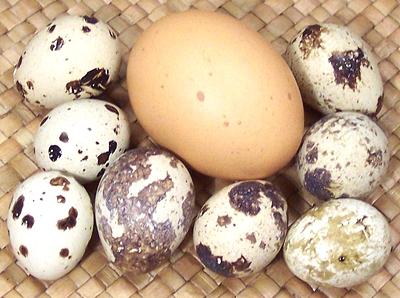Quail Eggs
 For many North Americans, their first encounter with quail eggs is at
Japanese sushi bars. Uni (sea urchin) with a raw quail egg broken over it
made as gunkan nigiri sushi is one of my favorites. Quail Eggs are favored all
over East and Southeast Asia, South America, and increasingly in North
America. They are also popular in Europe, where Ukraine is the largest
producer.
For many North Americans, their first encounter with quail eggs is at
Japanese sushi bars. Uni (sea urchin) with a raw quail egg broken over it
made as gunkan nigiri sushi is one of my favorites. Quail Eggs are favored all
over East and Southeast Asia, South America, and increasingly in North
America. They are also popular in Europe, where Ukraine is the largest
producer.
The photo specimens averaged 0.47 ounce, 1.47 inches long and 1.1 inches
diameter.The specked quail eggs found in markets here are generally from a
Japanese quail variety now widely raised for egg production. The photo
specimens came from Ontario, California. Some quail native to North
America and Europe lay white eggs but those quail are raised mainly
for eating, not egg production.
More on Eggs.
In the sushi bars quail eggs are most often used raw, but other Asian
peoples use them cooked. In Thailand they are fried sunny side up and
sold by street vendors 6 or 7 to a bowl. Jars and cans of quail eggs in
water are shipped from Vietnam and Thailand. Pickled ones are packaged
in North America. They are used as a delicacy or as a garnish.
Buying:
Fresh Quail Eggs are generally found in the egg
section of markets packed in tiny plastic egg cartons holding 10, 18, or
24 eggs. They are also available in cans, already hard cooked and peeled,
about 22 per 14 ounce can. Aroy-D brand from Thailand is very good.
I have encountered canned eggs that are quite spherical and almost all
yolk, with just a thin white layer. Fresh ones from California are pointier
and have a white to yolk ratio similar to chicken eggs, as do the canned
ones from Aroy-D.
Warning:
For fresh eggs, buy extras and cook and peel a day
in advance when you aren't rushed. Peeling takes patience and care due to the
small size and delicacy of the eggs, and the tough undershell membrane. You
will have some losses.
Cooking:
For must uses, they will be hard boiled.
- Prepare a pan that will hold the eggs in a single layer (but not too
much empty room) and pour in cold water enough to cover the eggs by
about 1/4 inch.
- In another pan, bring water to a boil. A few at a time, dip the eggs
into the boiling water for about 30 seconds, then place in the pan with
the cold water. This loosens the membrane.
- With the eggs in the pan of cold water, bring it to a boil, then
immediately turn off the heat. Let them sit for about 15 minutes.
- Bring eggs out of the water one at a time. crack lightly, then peel.
Working with cold running water helps. To keep them round, float them
in a container of cold water until they have completely cooled.
da_quailz 130416 r 240607 - www.clovegarden.com
©Andrew Grygus - agryg@clovegaden.com - Photos on this
page not otherwise credited are © cg1 -
Linking to and non-commercial use of this page permitted
 For many North Americans, their first encounter with quail eggs is at
Japanese sushi bars. Uni (sea urchin) with a raw quail egg broken over it
made as gunkan nigiri sushi is one of my favorites. Quail Eggs are favored all
over East and Southeast Asia, South America, and increasingly in North
America. They are also popular in Europe, where Ukraine is the largest
producer.
For many North Americans, their first encounter with quail eggs is at
Japanese sushi bars. Uni (sea urchin) with a raw quail egg broken over it
made as gunkan nigiri sushi is one of my favorites. Quail Eggs are favored all
over East and Southeast Asia, South America, and increasingly in North
America. They are also popular in Europe, where Ukraine is the largest
producer.